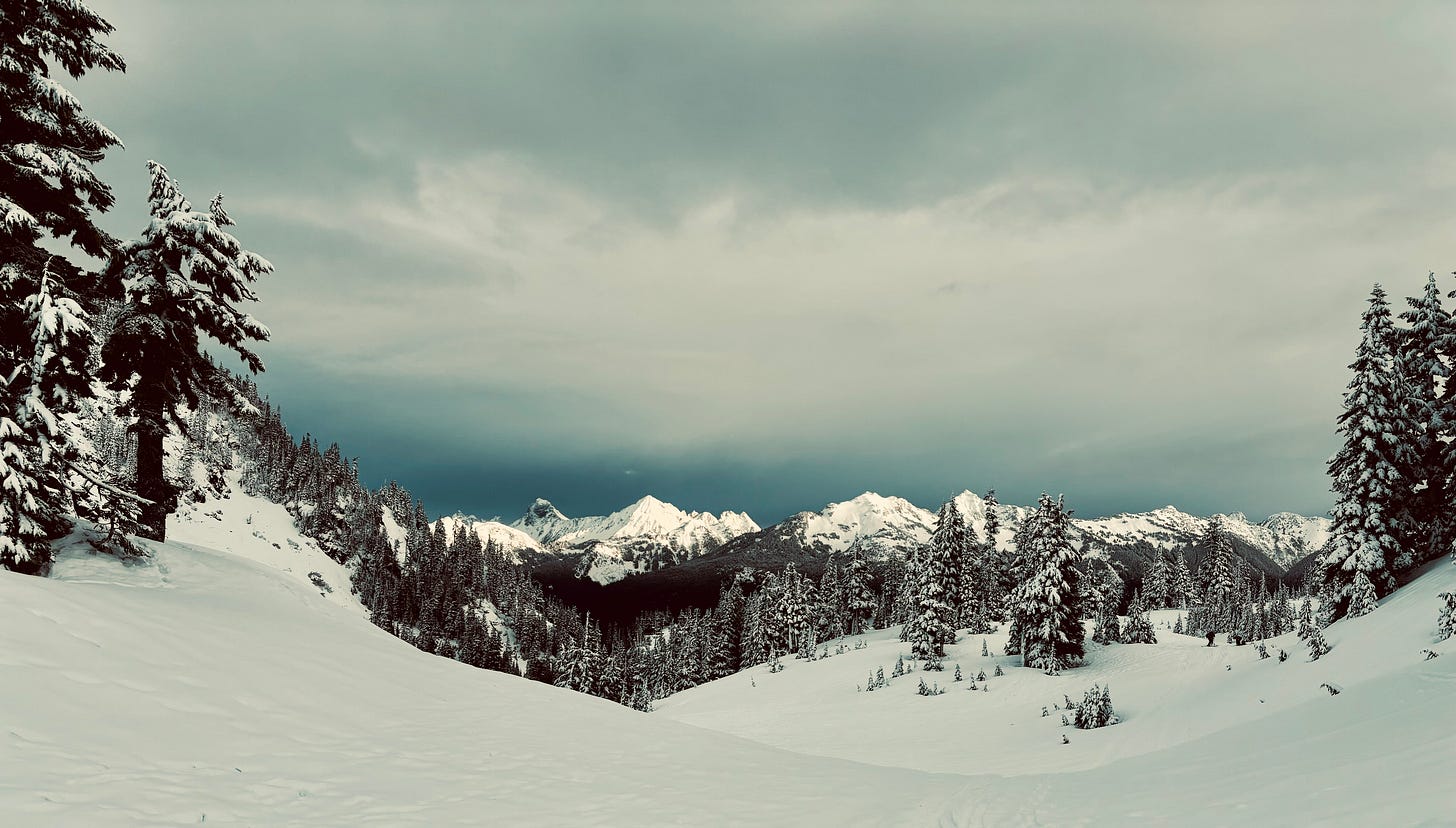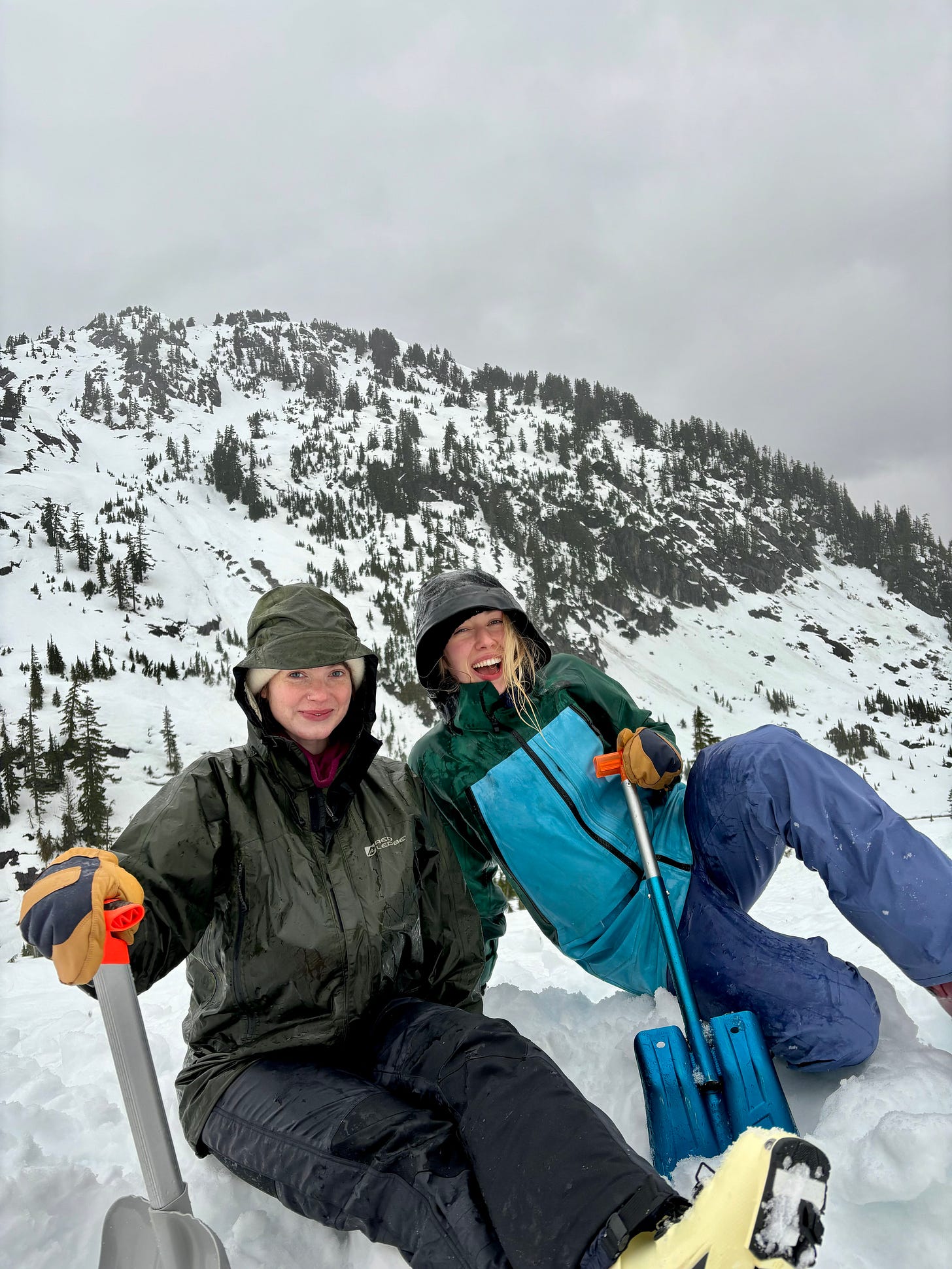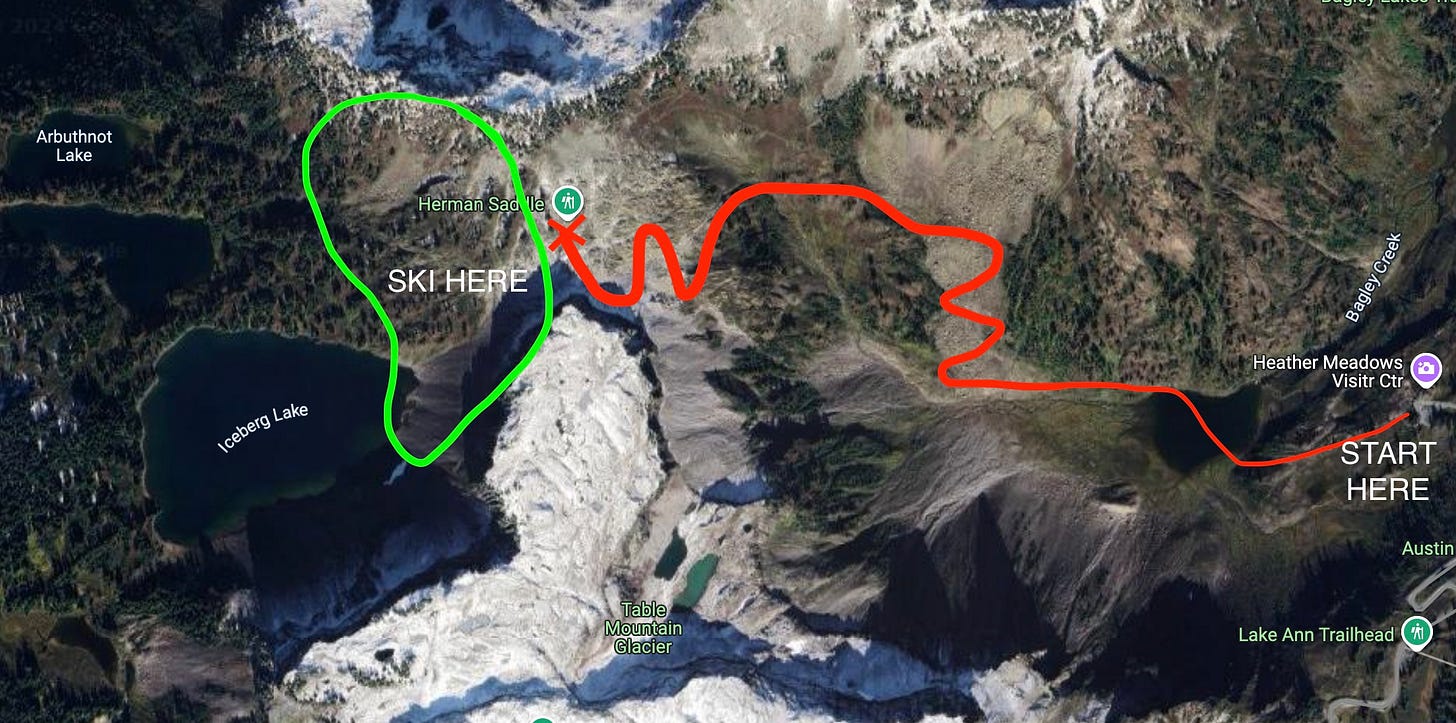The rain soaked us as we dug furiously through the avalanche debris. With each shovel strike, the clock ticked down toward our ten minute goal. With every passing second, the likelihood of survival dropped significantly. To describe the snow as heavy would have been an understatement. It was essentially like shoveling wet concrete. Buried two meters below us was our best friend.
This was the Mt. Baker backcountry and thankfully, it was practice for the real deal.
* In this post, I will be discussing my first experience with backcountry skiing. I am by no means qualified to teach these skills, and anyone interested in pursuing this sport should complete AIARE 1 training through a reputable provider. I took mine with Baker Mountain Guides and would highly recommend them.*
Backcountry skiing has been on my mind since college. I would be riding up the lift, looking out into the expanse of the Rocky Mountains and wondering what was beyond the red tape put up by ski patrol.
When I first learned to ski five or six years ago, all I knew was the Epic and Ikon passes. I’d heard stories of the days before these passes, when skiing didn’t cost over $1,000 for a season and the mountains weren’t overflowing with people. In college, I was lucky to use the student discounts, but post-grad has altered the priorities, and a ski pass is no longer an option. At the same time, not skiing isn’t an option! This season, I wasn't missing out—so a couple of friends and I signed up for a backcountry skiing class.
But really… why do this shit?
Why add another outdoor hobby, let alone one that could kill me? The simple answer is that I want to get outside during the winter. The real answer is that I can’t live without “this shit.” Being outside and chasing undiscovered terrain is my lifeblood. Whether it’s a new fishery, a new sport, or a new experience, I cannot seem to rest.
Maybe it’s my failing as a writer, but I struggle to describe it with words. It’s a feeling. It’s an emotion. It’s lustful!
It’s essential to my life and without the pursuit of outdoor adventure, I might as well cease to exist.
Why is training necessary for backcountry skiing?
In short, it’s because of avalanches and the dangers they create. If you’re not familiar, skiing is a thrilling sport that involves rapidly descending steep slopes on meticulously engineered sticks. Most people ski at resorts in which the terrain is managed by highly trained professionals to ensure safety from avalanches. Additionally, these resorts carry people up and down the mountain on various types of machinery so that skiers can enjoy the downhill without needing to climb up the mountain under their own power—a pretty sweet deal.
Backcountry skiing, on the other hand, takes place outside of a ski resort. There is no one managing the terrain and certainly no one carrying you up the mountain. The skier is responsible for all of this. Therefore, the gear and experience is quite different, and the risks are substantially higher.
Essential Gear
Regarding safety, there are three key pieces of gear:
Beacon: A handheld transceiver that helps locate buried skiers in the event of an avalanche.
Probe: A collapsible pole used to pinpoint a buried skier's exact location beneath the snow.
Shovel: A tool for digging out buried skiers and performing snow stability tests.
Regarding getting up and down the mountain, we need some special gear as well.
Ski Bindings: Bindings are the mechanism that attach a skiers boot to the ski. Backcountry bindings allow the heel to lift for uphill travel, unlike traditional bindings where the heel is fixed.
Climbing Skins: Long strips of material that attach to the base of your skis, providing grip for uphill travel. They work similarly to the barb on a fishing hook, allowing the ski to glide forward while preventing it from sliding backwards.
My first day in the backcountry.
After signing up for the class, I was instantly nervous. Thanks to a life spent below the equator, I hadn’t skied in two years and I wasn’t sure if I would remember how. To make matters worse (or better?), my ski training consisted of family members dragging me to the top of a black diamond and watching me double-eject my way down the mountain. For the record, I wouldn't have wanted to learn any other way. Nonetheless, I am not a graceful skier, and my time off fueled a nagging sense of imposter syndrome leading up to the course.
Soon enough, the time arrived, and the course began with an online, self-paced education curriculum that took about eight hours to complete. It covered the basics of backcountry travel and what you need to do to pursue this sport safely. By the end of the online class, I had learned an incredible amount, and the imposter syndrome began to wane. I was ready to get on the mountain.
On the night before the first field day, I spent a few hours laying out my gear, making sure everything worked, and checking that I knew how to use it. As a kid, on the night before a fishing trip, I would have a hard time sleeping. Over the years, I thought I had outgrown this, but it all came rushing back. I was up all night with thoughts swirling through my mind like a snowstorm. Thankfully, the imposter syndrome had disappeared, and I finally felt confident that I had what it takes.
Morning came, and the crew loaded up for the journey to the top of the mountain. We arrived, met our guide Kyle, and set off into the Mt. Baker National Forest. It was smooth sailing for everyone—except Sydney, who had put one of her skins on backward. I was just glad it wasn’t me.
On day one, we focused on the ins and outs of avalanche rescue and the basics of snow science. We learned how to locate a buried skier in an avalanche path and how to properly dig them out. In an avalanche, rescuers have about ten to fifteen minutes to excavate the person from the debris before they suffocate. Most victims are buried about a meter and a half deep, requiring the removal of about 2,000 to 3,000 pounds of snow. There were many points during this class that I was floored by the immense danger of this sport. That statistic was one of them, and it certainly makes you think twice about who you have on your team in the backcountry.
By the end of the day, we had moved thousands of pounds of snow, and everyone was soaking wet and exhausted. We headed to the bar, knocked back some beers, and then went home.
Day two was our opportunity to plan and execute a successful day in the backcountry. On Sunday morning, I awoke with a pep in my step—tired but excited. The weather looked promising, the tour we had planned was picturesque, and I was about to open up a whole new world of outdoor adventure.
We planned to make our way to Bagley Lake, cross the frozen body of water (hopefully without falling through), and then skin around the edge toward the boulder field. Finally, we would summit over Herman Saddle and have our fun on the other side.
We began our tour, and within thirty minutes, snowflakes started falling. After an hour, we could see a large storm brewing on the horizon. Soon enough, the wind was gusting with a vengeance and it became increasingly difficult to see. By the time we crested Herman Saddle, it was a whiteout, and it became apparent that Mother Nature had her own weather plan for the day. The wind was gusting upwards of forty miles an hour and it took everything we had to avoid tumbling off the side of the mountain. We decided to move into the trees for some protection and to prepare for the ski down.
One by one, our group launched down the mountain. Hoots and hollers echoed off the peaks as we descended into the snowy wonderland below. The run was incredible—fresh snow, steep lines, and just enough trees to ward off the vertigo. At the bottom, we regrouped and quickly transitioned into uphill travel mode, beginning the climb back to the shit storm at the top of the mountain. With about two hours until sunset and the weather worsening, we knew we needed to move quickly.
When we reached the top, the wind had intensified, and it was miserable. We wasted no time on the ridgeline before starting our descent. I was elated when we finally reached Bagley Lake and it was time to put the skins back on.
We made it safely back to the car, and while we were gone, over six inches of fresh snow had blanketed everything. We peeled off our ski gear and, once again, headed to the bar for a debrief. Beers made the rounds as we talked about the day—what we did well and what we would do differently next time.
The drive back to Bellingham was filled with joy as the gang was ecstatic to be out of the elements and proud to have completed our avalanche training. Now, we felt free—free to explore the backcountry on our own, free to make our own mistakes, and free to lead our own adventure.
Few human experiences come close to the feeling of outdoor adventure. Here are a couple that compare:
A multiday music festival
Time spent with loved ones
Psychedelics and religious experiences
Achieving a goal
Falling in love
Losing love
Backcountry skiing is a new pursuit of mine. While it won’t replace fishing, it’s something I intend to pursue to the nth degree. I’m excited to share stories from the backcountry with all of you. Kudos, my friends—I hope you spend some time outside.








Great work bro! Living vicariously through you this winter!
Great story and I learned a lot! Moving a ton of snow sounds exhausting!
When I was growing up ( in CA), I had a good friend who was Swiss and a real adventurer. His father was trying to mainstream a system for backcountry skiing that included a parachute to catch the wind to pull you up the mountain. Then you’d pack it in a backpack and ski down. It obviously didn’t catch on, but sounded cool. The guy was a kickass skier, though. Probably not for mortals.